Nathan Tappan Condol, Teacher
(From May 1991 Historical Society Newsletter)
Although Geneva’s first public school opened in 1796, it appears that African American children were not allowed to attend it . Until the late 1830’s Sunday Schools were the only formal education in Geneva available to African Americans. By 1834, a chapel and Sunday School building had been erected on a High Street lot owned by Aaron Lucas. In 1837, 72 black children began to use this building as a district school. Despite the passage of an 1841 state law requiring that public schools be open to all children, the village school district tabled African Americans’ petition that a tax be collected to build their children a school. In 1849, Presbyterian clergyman and nationally known abolitionist Henry Highland Garnett was assigned to Geneva to preside over the African American school and church. As a result of his efforts, the district finally acted and by 1853 had built the High Street or West Branch School across the street from the chapel.
Nathan Tappan Condol was born in 1843, the youngest of eleven children born to William and Chloie Condol who moved from Connecticut to Geneva the year he was born. The Condol family lived in a two-story house, across the street from the High Street chapel where young Nathan may have been a student of Garnet. By 1862, Condol began to teach at the segregated High Street School. At about the same time he became a subscription agent for the American Missionary Association’s periodical American Missionary. The American Missionary Association worked with the American Freedmen’s Union Commission to organize, build, equip, and staff schools for southern freedmen. In 1864 Condol began to seek a teaching position in one of these schools. His first of several letters seeking a teaching position is partially reprinted below:
I am a single man, aged 23 yrs and have been desirous of assisting in the edification of my race for some time past, but at present I would require (as I am now teaching in Geneva) thirty-two dollars per month and to be located in the vicinity of Washington and would engage for six months as required in the circular….

Circa 1880 view of people standing outside the High Street School built in 1853. Nathan Tappan Condol taught here in the mid-1860s.
In May 1865, the Geneva Colored Ladies Freedom and Soldier’s Aid Society raised money to help pay Condol’s tuition at Oberlin College. It was from Oberlin that he wrote the following, excerpted from a letter to Rev. George Whipple, Secretary of the American Missionary Association:
You will remember that a little more than a year ago, the Rev. R.J. Johnston gave my name to the Association as an applicant to go south as a teacher. At that time I was engaged in teaching a school at Geneva, and have been ever since until I left to come here. I could no longer teach, on the account of being deeply impressed, that my labors were wanted south. I came to Oberling by the assistance of a few friends, for the purpose of spending a few terms in academical training and since I have been here, I have been unable to content myself, for the reason of feeling intensely that I am called upon by the Supreme Being working within, to go immediately south and work in His vineyard. I have just come from Pres Finney whom I have told my feelings, and he advised me to write to the association and procure an appointment to go south… I can not live under that state of mind, that I am now in. Every sermon and lecture I hear, seem to be directed right to me, and I call upon me to be doing something. Not a moment passes, but what I feel, I am not doing my duty. I ask you, therefore, to give me an appointment somewhere south, I care not where so long as I know I am not working for myself.
Condol continued his studies at Oberlin until the end of the year when he was sent to Aberdeen, Mississippi to establish a school. He was one of only five African-Americans from New York sent to teach in freedmen’s schools. Condol taught as many as 300 students a term until 1878 when he died in a yellow fever epidemic. The following is excerpted from his first report to Whipple, dated April 21, 1866:
On the 8th of Jan. the first colored school was organized in Aberdeen, Miss., by the undersigned. During this time we have had under our supervision 272 scholars, none were advanced more than to read in three letters, t,h,e …all others in their a b abs or in the Alphabet. Friday afternoon and evening, the 13th inst. we had our First Exhibition. On that day we had scholars reading fluently in the Third Readers, answering questions half though Geography No. 1 from the beginning, without a failure and through the Prog. Table [torn]. Several of the distinguished Gentlemen of the City were present… all of who spoke encouragingly to the gathering which numbered, perhaps, 800, or mor. They expressed themselves to be greatly surprised, yet highly pleased with the progress the scholars had made during so short a period (three months) and also remarked, that, even now, our school would compare favorably with any school in the state, white or black, some informed me that they went for the purpose of having fun, but I assure you their fun was of a different character than they expected… We receive a great many abuses, and threats but mind them not. Our trust is in the Lord; if we live, we live; if we die, we die; we have no fears, whatever. Our work ceases neither day nor night.
This article was brought to you in part by our supporters. Be our partner in telling Geneva’s stories by becoming a Historic Geneva supporter.


Great Article from over 30 years ago. Very timely as February is Black History Month.